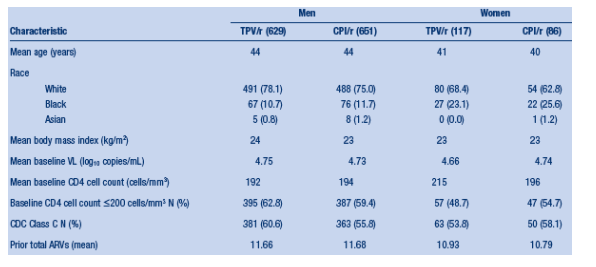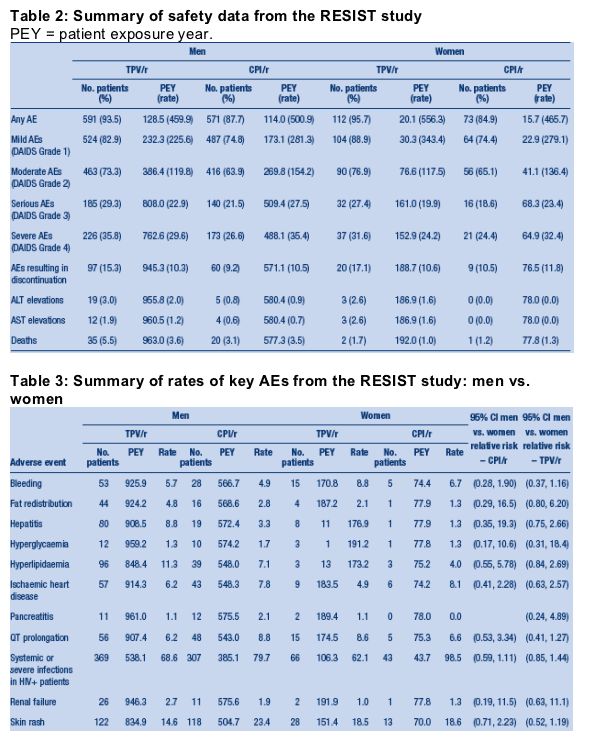 |
 |
 |
| |
Tipranavir/ritonavir (500/200 mg BID) demonstrated potent and durable virologic responses, and a favourable safety profile, in
HIV-1 positive women participating in RESIST
|
| |
| |
Reported by Jules Levin
4th IAS Conference, July 2007, Sydney, Australia
Sharon Walmsley1, Kathleen Squires2, M Kraft3, J Scherer3,
Laurence Weiss4, Philippa Easterbrook5, Anna Orani6
1Toronto General Hospital, University of Toronto, Canada; 2Jefferson Medical College, Philadelphia, USA; 3Boehringer
Ingelheim, Ingelheim, Germany; 4Hopital Europeen Georges Pompidou Service d'Immunologie clinique, Paris, France;
5Kings College Hospital, London, UK; 6Clinica di Malattie Infettive, Lecco, Italy
Author Conclusions
- This analysis evaluated the efficacy and safety of TPV/r and CPIs/r in the 203 treatment-experienced women who participated in the RESIST trials.
- Over 48 weeks, there were no gender-related differences in terms of virological efficacy and safety in RESIST patients taking TPV/r, despite higher steady-state plasma TPV trough concentrations in women than men.
- Women taking TPV/r experienced significantly greater CD4 cell increases than men in RESIST.
- The results of the SPRING study and other planned studies will help physicians further define gender and racial differences in responses to tipranavir/r in treatmentexperienced patients.
Abstract
Objectives: To evaluate efficacy and safety of tipranavir/r (TPV/r) in treatment-experienced women.
Methods: Sub-analysis of Week 48 efficacy and safety RESIST data. PK samples were obtained 10-14 hours post-dosing.
Results:
12.6% of RESIST participants were women: 117 TPV/r; 86 CPI/r. Men and women had similar baseline characteristics.
At Week 48, 22.1% (139/629) men and 25.6% (30/117) women randomised to TPV/r had VLs <50 copies/mL (ITT NCF). After adjusting for PI stratum, enfuvirtide use, and background RTI sensitivity, mean VL change at last observation to Week 48 from baseline was -1.30 (95% C.I. -1.49,
-1.10) log10 copies/mL for men and -1.46 (95% C.I. -1.74 to -1.18) log10 copies/mL in women taking TPV/r (p=0.1890). A Logistic regression
analysis gave Odds Ratio of 1.15 (95% CI 0.71-1.84; p=0.5728) for TPV/r virological responses (Week 48 VL <50 copies/mL) in women vs. men.
The adjusted mean CD4 change from baseline at Week 48 was: men: +52.4 (36.8, 67.9); women: +84.2 (61.5, 106.9) (p=0.0017). Although women had higher steady-state plasma TPV trough concentrations than men (adjusted
means: 45.3 _M vs. 38.75 _M; lower detection limit: 1.6 _M), the overall safety profile of TPV/r was similar in both sexes.
Overall AEs per patient exposure year (PEY) were slightly higher in TPV/r-treated women (556.3) than men (459.9) but rates of AEs leading to discontinuation were similar (women: 10.6; men: 10.3).
Severe (women: 24.2; men: 29.6) or serious (women: 19.9; men: 22.9) AE rates were slightly higher for men. Rates of bleeding, fat redistribution, hepatitis, hyperglycaemia, hyperlipidaemia, IHD, pancreatitis, QT prolongation, systemic/severe infections, renal failure, skin rash indicated no significant gender differences.
Conclusions: Over 48 weeks, no gender-related differences in efficacy and safety were seen in RESIST patients taking TPV/r, despite higher steady-state plasma TPV trough concentrations in women. Women experienced greater CD4 cell increases.
Introduction
Worldwide, nearly 18 million women are living with HIV infection. Women of African and Latin American decent are disproportionately affected and account
for a large number of infections in both developing and developed countries. Women currently account for almost 30% of new HIV diagnoses in the USA
and HIV infection rates are particularly high amongst women of colour. HIV clinical trials are underpowered to address gender differences, and although the cohort studies indicate similar efficacy rates, there are increasing amounts of data suggesting that women may have different tolerance issues with antiretroviral (ARV) medications compared to men. Future studies need to focus on these potential differences.
There is an urgent need to investigate the efficacy and safety of antiretroviral drugs in HIV positive women since they are under-represented in most clinical studies. The recently initiated SPRING study will gather data on treatment outcomes in ARV experienced women [1]. The SPRING (Safety, efficacy and Pharmacokinetics of tipRanavir boosted with low dose ritonavir (500 mg/200 mg)
twice daily IN 400 racially and Gender diverse HIV-positive treatment-experienced population) study is a Phase IIIb, open-label, multi-centre, multinational trial with a primary endpoint of an undetectable viral load (<50 copies/mL) at 48 weeks. SPRING will examine the safety, efficacy and pharmacokinetics of Aptivus (tipranavir) in a racially diverse group of
200 female and 200 male treatment-experienced patients across eight countries in three continents. Until data from SPRING are available, it is important
to evaluate data from women who took part in large Phase III trials, such as RESIST [2]. The aim of this analysis was to evaluate the efficacy and safety of
tipranavir/r (TPV/r) and comparator ritonavir boosted protease inhibitors (CPI/r) in the 203 treatment-experienced women who participated in the RESIST trials. Pharmacokinetic (PK) analyses were undertaken to determine if there was a
relationship between plasma drug levels of tipranavir and the PI's safety profile.
Methods
A sub-analysis of efficacy and safety RESIST data was conducted. Intent to Treat, non-completer= failure (ITT NC=F) methodology was used for the efficacy analyses unless otherwise stated. The safety data were based on all available data up to the date used for the Week 96 analysis i.e. October 28, 2005.
Samples for pharmacokinetic (PK) analysis were obtained 10-14 hours post-dosing.
Results
Two hundred and three (203) treatment-experienced women participated in the RESIST trials, accounting for 12.6% of the RESIST population: 117 were
randomised to TPV/r and 86 to a CPI/r. Men and women had similar baseline characteristics in terms of age, body mass index, baseline viral load (VL), CD4 cell count, proportion of patients who were classed as CDC Class C and number of prior ARVs (Table 1). Approximately 11% of the men in RESIST were black compared to approximately 23% of the women.
At Week 48, 22.1% (139/629) men and 25.6% (30/117) women randomised to TPV/r had VLs <50 copies/mL (ITT NCF) (Figure 1). After adjusting for PI stratum, any enfuvirtide use, and background RTI sensitivity, mean VL change at last observation to Week 48 from baseline was -1.30 (95% C.I -1.49, -1.10) log10 copies/mL for men and -1.46 (95% C.I. -1.74 to -1.18) log10 copies/mL in
women taking TPV/r (p=0.1890) (Figure 2).
A Logistic regression analysis gave an Odds Ratio of 1.15 (95% CI 0.71-1.84; p=0.5728) for TPV/r virological responses (Week 48 VL <50 copies/mL) in women vs. men. These data show that there were no significant gender differences in terms of virological responses to TPV/r.
Table 1: Baseline characteristics of men and women who participated in the RESIST study
Baseline CD4 count was mean 215 for women on TPV/r and 192 for men. 23% of women on TPV/r were Black and 10.7% of men were on TPV/r.

The adjusted mean CD4 change from baseline at Week 48 in the TPV/r arm was: men: +52.4 (36.8, 67.9) cells/mm3; women: +84.2 (61.5, 106.9) cells/mm3 (p=0.0017) (Figure 3). Women had higher (+17%) steady-state plasma TPV trough concentrations than men. The adjusted mean values were 45.3 _M for women vs. 38.75 _M for men. The lower detection limit of the assay was 1.6 _M.
Despite the higher steady-state plasma TPV trough concentrations in women, the overall safety profile of TPV/r was similar in both sexes. Overall AEs per patient exposure year (PEY) were slightly higher in TPV/r-treated women (556.3) than
men (459.9) (Table 2). However, rates of AEs leading to discontinuation were similar (women: 10.6; men: 10.3). PEY rates of severe AEs (women: 24.2; men:
29.6), serious AEs (women: 19.9; men: 22.9) or moderate AEs (women: 117.5; men: 119.8) were higher for men while the rate of mild AEs was higher in women (women: 343.4; men: 225.6). The majority of AEs in both men and women were
mild-moderate and resolved without clinical sequelae. Table 2 also summarises the rates of liver enzyme elevations, which were very similar for men and women (ALT: women: 1.6; men 2.0; and AST: women: 1.6; men: 1.2)
Rates of bleeding, fat redistribution, hepatitis, hyperglycaemia, hyperlipidaemia, IHD, pancreatitis, QT prolongation, systemic/severe infections, renal failure, skin rash indicated no significant gender differences (Table 3).

References
1. Boehringer Pharmaceuticals. SPRING-Safety, Efficacy, PK of TPV/r IN Race/Gender HIV+ Patients With TDM or Standard Care in Multinational Centers. NCT00440271. 2007
Available from: http://www.clinicaltrials.gov/ct/show/NCT00440271/order=1.
2. Hicks, C.B., et al., Lancet, 2006. 368(9534): p. 466-75.
|
| |
|
 |
 |
|
|